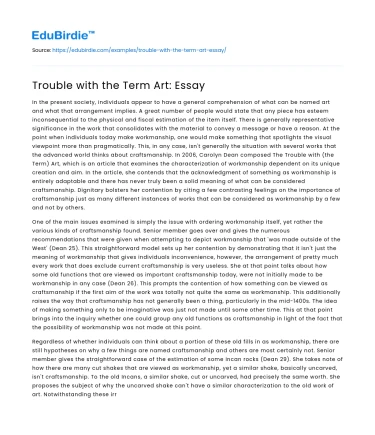In the present society, individuals appear to have a general comprehension of what can be named art and what that arrangement implies. A great number of people would state that any piece has esteem inconsequential to the physical and fiscal estimation of the item itself. There is generally representative significance in the work that consolidates with the material to convey a message or have a reason. At the point when individuals today make workmanship, one would make something that spotlights the visual viewpoint more than pragmatically. This, in any case, isn't generally the situation with several works that the advanced world thinks about craftsmanship. In 2006, Carolyn Dean composed The Trouble with (the Term) Art, which is an article that examines the characterization of workmanship dependent on its unique creation and aim. In the article, she contends that the acknowledgment of something as workmanship is entirely adaptable and there has never truly been a solid meaning of what can be considered craftsmanship. Dignitary bolsters her contention by citing a few contrasting feelings on the importance of craftsmanship just as many different instances of works that can be considered as workmanship by a few and not by others.
One of the main issues examined is simply the issue with ordering workmanship itself, yet rather the various kinds of craftsmanship found. Senior member goes over and gives the numerous recommendations that were given when attempting to depict workmanship that 'was made outside of the West' (Dean 25). This straightforward model sets up her contention by demonstrating that it isn't just the meaning of workmanship that gives individuals inconvenience, however, the arrangement of pretty much every work that does exclude current craftsmanship is very useless. She at that point talks about how some old functions that are viewed as important craftsmanship today, were not initially made to be workmanship in any case (Dean 26). This prompts the contention of how something can be viewed as craftsmanship if the first aim of the work was totally not quite the same as workmanship. This additionally raises the way that craftsmanship has not generally been a thing, particularly in the mid-1400s. The idea of making something only to be imaginative was just not made until some other time. This at that point brings into the inquiry whether one could group any old functions as craftsmanship in light of the fact that the possibility of workmanship was not made at this point.
Save your time!
We can take care of your essay
- Proper editing and formatting
- Free revision, title page, and bibliography
- Flexible prices and money-back guarantee
Regardless of whether individuals can think about a portion of these old fills in as workmanship, there are still hypotheses on why a few things are named craftsmanship and others are most certainly not. Senior member gives the straightforward case of the estimation of some Incan rocks (Dean 29). She takes note of how there are many cut shakes that are viewed as workmanship, yet a similar shake, basically uncarved, isn't craftsmanship. To the old Incans, a similar shake, cut or uncarved, had precisely the same worth. She proposes the subject of why the uncarved shake can't have a similar characterization to the old work of art. Notwithstanding these irregular rocks, Dean centers around a quite certain Incan stone. The Funerary Rock is an enormous stone that is, generally, thought to be a masterpiece (Dean 28). Senior member contends that if this equivalent shake were to be moved away from the mountainside, where it has its emblematic importance, it would never again be craftsmanship as a result of its loss of significant worth. This at that point raises the issue of why something would be craftsmanship in one area with a particular encompassing and not be workmanship if it somehow happened to be moved elsewhere. These models just expand on the insecurity of the phrasing of craftsmanship.
In this article, Carolyn Dean has made a few points with solid proof that portray the issue that the advanced world has with the term 'workmanship'. A clear dominant part of Dean's contention was comprised of perceptions from the Incas. This could persuade that her involvement with this old realm has brought about a one-sided contention. One could contend that the assorted variety of models was too missing to even consider providing a sensible situation on the contention. One could likewise contend that one model that presents such a significant number of issues with the characterizing of craftsmanship is sufficient to make a solid case. In spite of the fact that practically the majority of Dean's models are identified with the antiquated Incan Empire, there is sufficient proof to help her contention with the restricted scope of models or sources. The article seemed to now and then expound that didn't generally give anything to help the contention. Notwithstanding these couple of events, a dominant part of the data gives unequivocal detail on the numerous ways individuals keep running into issues when making an endeavor to order a few things as workmanship. These clashing thoughts meet up to put accentuation on the adage of how magnificence is subjective depending on each person's preferences.
Did you like this example?
Make sure you submit a unique essay
Our writers will provide you with an essay sample written from scratch: any topic, any deadline, any instructions.
Cite this paper
-
APA
-
MLA
-
Harvard
-
Vancouver
Trouble with the Term Art: Essay.
(2023, March 01). Edubirdie. Retrieved December 22, 2024, from https://edubirdie.com/examples/trouble-with-the-term-art-essay/
“Trouble with the Term Art: Essay.” Edubirdie, 01 Mar. 2023, edubirdie.com/examples/trouble-with-the-term-art-essay/
Trouble with the Term Art: Essay. [online].
Available at: <https://edubirdie.com/examples/trouble-with-the-term-art-essay/> [Accessed 22 Dec. 2024].
Trouble with the Term Art: Essay [Internet]. Edubirdie.
2023 Mar 01 [cited 2024 Dec 22].
Available from: https://edubirdie.com/examples/trouble-with-the-term-art-essay/
copy






 Stuck on your essay?
Stuck on your essay?

